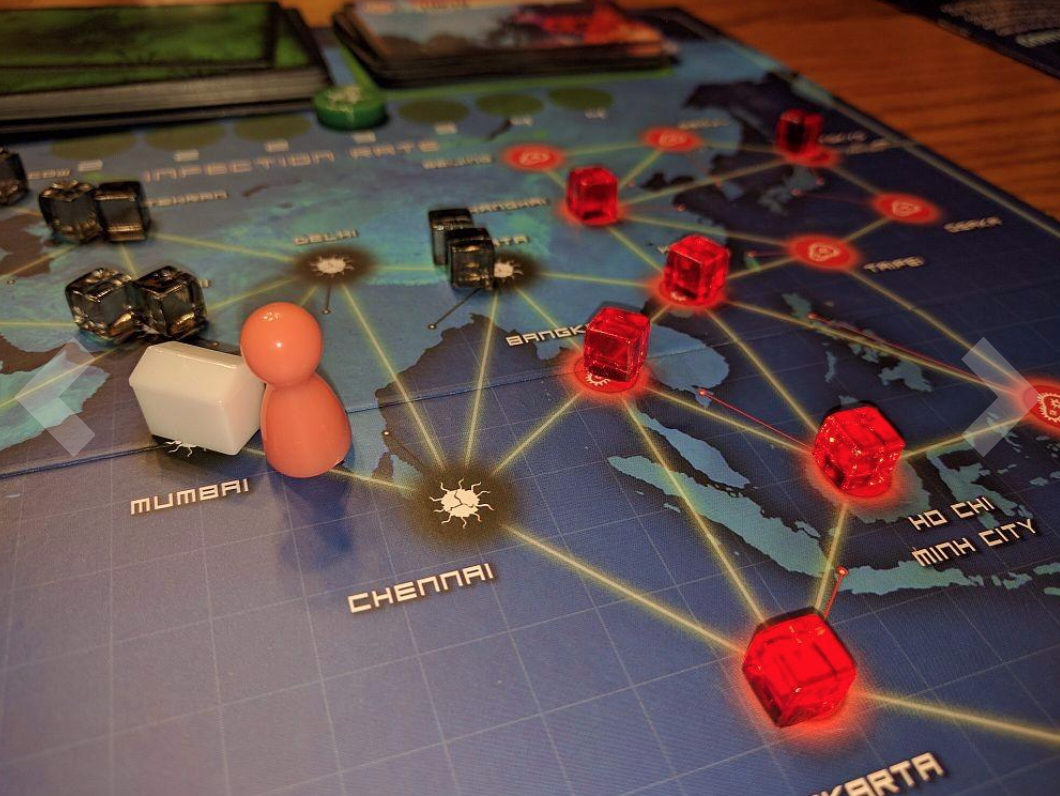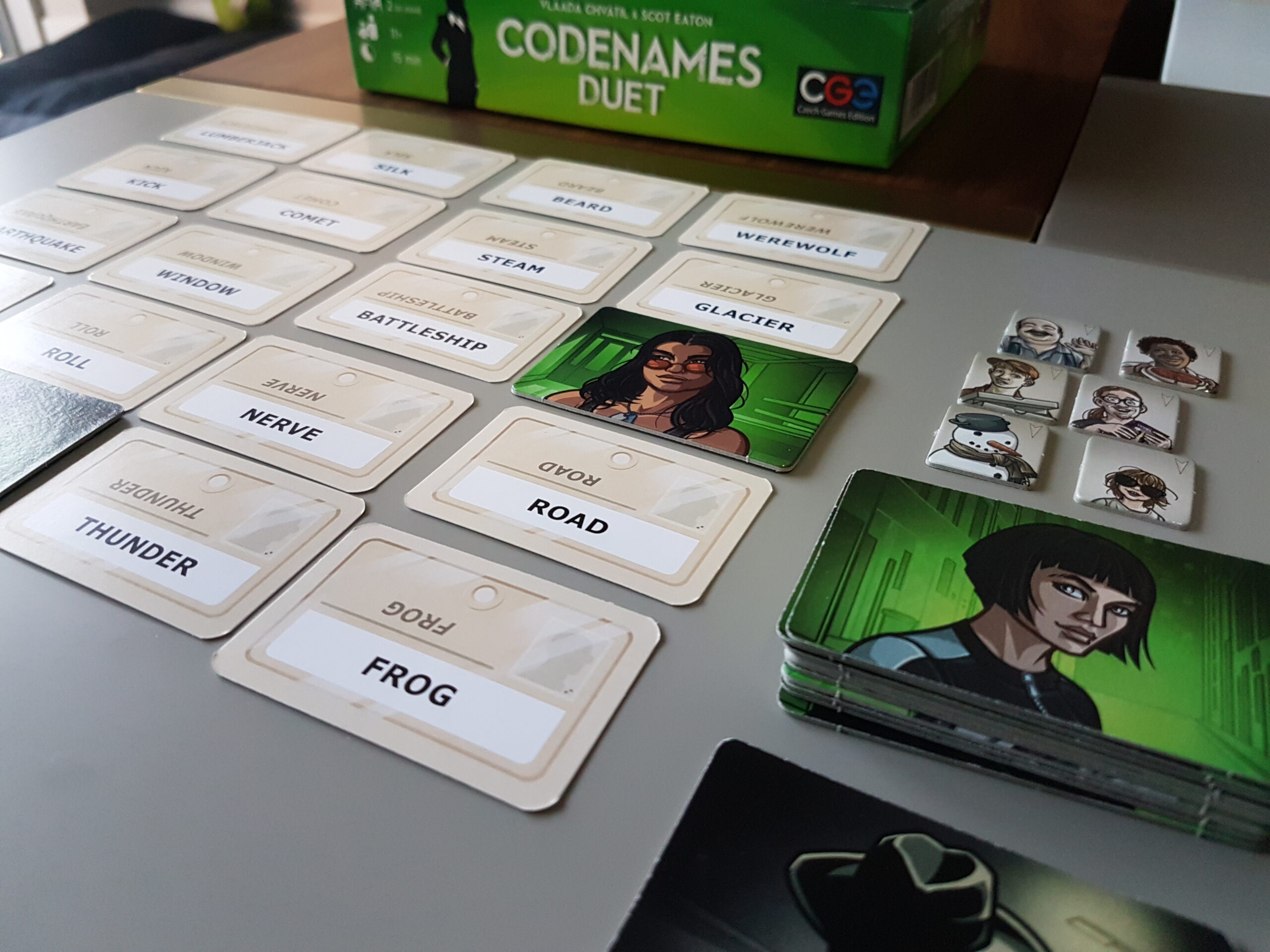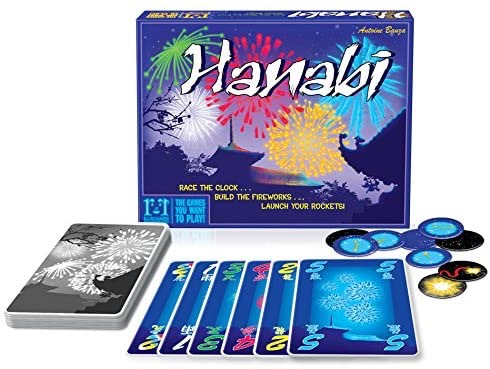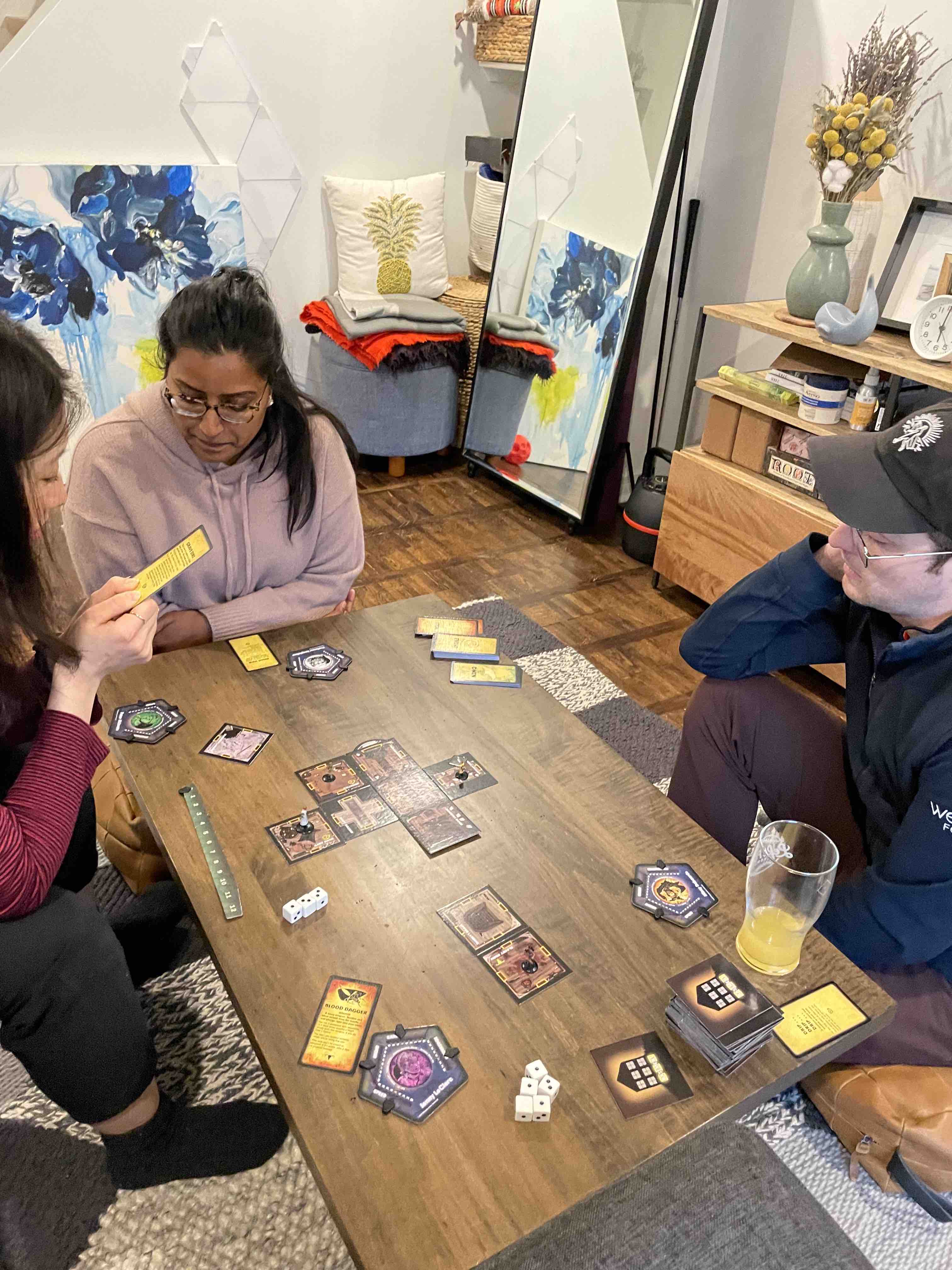I’ll admit, cooperative two-player board games aren’t my forté. I mean, working together to reach a common goal is nice and all. But, where’s the action, the suspense, and the thrill?
Well, to be fair, some cooperative two-player board games are unbelievable to play. They perfectly balance intense game dynamics, encourage strategic gameplay, and earn the title of high re-playability.
To me, these are some of the most important aspects of a cooperative board game.
So, grab a friend, a spouse, or a co-worker and play these 6 best cooperative two-player board games [as voted by Reddit].
Article Contents:
- Forbidden Desert · 45 – 55 mins · 2 to 5 player
- Pandemic · 45 – 55 mins · 2 to 4 player
- Flash Point: Fire Rescue · 45 – 55 mins · 2 to 6 player
- Codenames Duet · 20 – 30 mins · 2 player
- Burgle Bros. · 45 – 90 mins · 2 to 4 player
- Hanabi · 20 – 30 mins · 2 to 5 player
Gameplay: 45 to 55 minutes
Players: 2 to 5
Transportability: Medium
Difficulty to Learn: Medium
Setup Time: 5 minutes
Expansions: No
Price: $30 – $40

Legend has it, an ancient airship is buried under the ruins of a city, just waiting to be discovered. Sounds interesting, right?
Well, as long as you can find all the airship piece in time and don’t get buried under a mountain of sand or die of thirst, you’ll be fine… I’m not joking.
Quick Rules
To start, each player is dealt a role card, which outlines actions and special abilities. Each player also keeps track of how much water remains in their canteen with a water meter marker. Water is a critical aspect of forbidden desert (just like in real life, people!).
The board is created by placing 24 desert tiles in a 5 x 5 grid, leaving a space in the middle. This space represents the location of the storm [cue Darude – Sandstorm music]. Sand markers are placed on top of the tiles in a diamond pattern. An initial difficulty level is selected and the storm meter marker tracks the level of the storm (which increases) throughout the game.
Starting from the crash site tile, all players can take up to 4 actions, or 1 free action:
- Move a space: moving to an adjacent tile (not diagonal) with fewer than 2 sand markers.
- Remove sand: remove a sand marker from the tile that you are on, or adjacent to (not diagonal).
- Excavate a tile: you can flip over a desert tile you are on that is not covered by sand.
- Collect an airship part: you can collect an airship piece if the tile is excavated with one or zero sand markers.
- Give water [free action]: if two players are on the same tile, one player can drop one water level so the other can gain a water level.
The goal is to recover all airship pieces by flipping over tiles, deciphering the clues to their location, and bring them to the excavated launch pad tile to escape. Some excavated tiles reveal helpful items such as sun sheltering and connecting tunnels, water wells to refill canteens, or an opportunity to draw a Gear Card.
Gear cards offer special abilities such as shielding you from the sun, blasting away all sand markers from a tile, rocket packs to fly to another tile, and others.
After a player completes their four actions, they draw cards from the storm deck pile equivalent to the storm level. Storm deck cards can do the following:
- Increase the level or intensity of the storm (Storm Picks Up), and the storm meter shifts up.
- All players not sheltered in a tunnel or protected by a solar shield lose one water level (Sun Beats Down).
- Move the storm position (Storm Movement Card). Any tiles effected by the movement of the storm have a sand marker placed on it.
As the game progresses, the storm space shifts around and players take turns completing their four actions or free action, and drawing and playing storm deck cards. Gameplay continues until one of the following occurs:
- The storm meter level reaches the skull and crossbones (Loss)
- A player’s water meter drops below what’s left in their canteen (Loss)
- There are no more sand markers available to be placed if required (Loss)
- Win: All 4 airship pieces have been recovered, the launch pad is excavated, and all players are on the tile.
Why it’s Great
After playing your first game of Forbidden Desert, my guess your first words will be “nature is a vengeful b*tch!”
This cooperative two-player board game is intense and captivating from the first move. Winning (and most likely losing) relies on working together, utilizing your combined special abilities, and making smart choices.
So, will you work together to survive the elements and find the hidden airship pieces? Or, will you shrivel up and die due to a lack of water and get buried under the sands of time?
Looking for the complete rules to play Forbidden Desert? Check them out here.
Gameplay: 44 to 55 minutes
Players: 2 to 4
Transportability: Low
Difficulty to Learn: Medium
Setup Time: 5 minutes
Expansions: Yes
Price: $80 – $90

An uncontrolled outbreak of disease is sweeping across the globe. Your goal – Contain the spread of pathogens and find the cure before it’s too late!
Well, similar to the Spanish Flu and, more recently COVID-19, Pandemic is a hyper realistic two-player cooperative board game that pits human-kind against potentially world-ending diseases.
So, can you work together to research, eradicate and ultimately cure infectious diseases [from the comfort of your living room table]? There’s only one way to find out.
Quick Rules
Each player is given a role card randomly. For two-players, each receive 4 Player Cards.
To set up the board, a research station and all player pawns start in Atlanta, where the Centers for Disease Control actually exists! Infection rate and outbreak markers are placed on their first positions, respectively.
The Infection Deck is shuffled and nine cards are drawn. The first three cities get 3 Infection Cubes of the color shown, the next three get 2 cubes, and the final three get 1 cube each. All infection city cards are placed in the infection discard pile.
Now, to prepare the player deck pile, the deck is split into 4 equal piles. One epidemic card is placed on top of each pile. Each pile is shuffled separately. Then, each pile is placed on top of one another onto the player deck draw pile, but not shuffled together as a whole.
On your turn, you (1) perform four actions, (2) draw two cards from the player deck pile, and (3) draw infection cards to see which cities get infected.
(1) Player actions include:
- Curing: If you have 5 player cards of the same color in your hand and you are on a research station you can cure a disease.
- Treating: You may remove 1 disease cube from the city you are currently in. If that disease is cured, you may remove all disease cubes of that color.
- Building: You can build a research station on the city you are on by discarding that cities card.
- Sharing: If you are on the same city as another player, you can share or receive 1 player card from them. However, the city you share can only be the one you are standing in.
- Moving: You may move to an adjacent / connected city on the map. You may also travel from one research station to another. Discarding a city card allows you to travel to that city from a research station. Alternatively, discarding the city card you are in allows you to travel to any other city.
Event Cards can be played at any time and do not count as an action. Players can hold no more than 7 cards in their hand, and must discard down to 7.
(2) Draw Player Deck Cards
When drawing from the player deck pile, sometimes an Epidemic Card is drawn. When this happens, immediately move the infection rate marker to the right. The bottom card in the infection deck is selected and three disease cubes are placed on that city. The discarded infection pile is shuffled and placed onto of the infection pile.
(3) Draw Infection Cards
The number of infection cards that are drawn are equivalent to infection level on the board. Place one disease cube on each city drawn. If a city already has three cubes and another cube needs to be placed on it, an outbreak occurs instead and all adjacent cities receive one disease cube of the same color. When an outbreak occurs, the outbreak meter moves one position.
After you’ve cured and removed all disease cubes of a certain color, congratulations, the disease in now eradicated. No more disease cubes of that color will spawn!
To win, players must cure all four diseases before 8 outbreaks occur, all disease cubes of any colour are all used, or the player deck pile runs out.
Why it’s Great
Well before the Coronavirus outbreak took a stranglehold on the planet, Pandemic perfectly emulated the spread of similar infectious diseases.
And, just like the response across the world, people have worked together to save lives and to stop its spread.
So, because the game dynamics are very true-to-life, and collaboration is key, Pandemic is a fantastic two-player cooperative board game. You’ll be playing over and over, regardless if you’re in lockdown or not.
Looking for the complete rules to play Pandemic? Check them out here.
Gameplay: 45 to 55 minutes
Players: 2 to 6
Transportability: Low
Difficulty to Learn: Medium
Setup Time: 5 minutes
Expansions: Yes
Price: $55 – $65

You get the call: a 3-alarm blaze has fully engulfed a neighborhood home. As firefighters, you rush to the scene. You’ll need to act quickly and cooperatively to control the blaze, rescue people and pets, and get out before the building collapses.
So, can you rise up to the challenge and perform your job with honor and valor? Or, will you succumb to the fire and smoke, and lay defeated amongst the ashes and rubble?
Quick Rules
In Flash Point, players are firefighters who move through a burning home, cut through walls, remove smoke and put out fires. The goal is to find and rescue at least 7 victims (people and pets). There are two types of game modes to choose from: Family (recommended for first timers) and Experienced.
The board itself is double sided, depicting two building layouts. Selected one side and place the door markers, threat markers and points of interest markers on the board as per the rule book.
The remaining points of interest (shuffled, question mark side up), threat markers, and damage cubes, as well as action tokens are placed next to the board. Each player selects a firefighter figure and the same color firefighter card to place in front of them.
Starting from the outer edge, players take turns navigating the grid layout of the building, one space at a time. On each turn, players must complete four steps: (1) Take action, (2) Advance fire, (3) Flip smoke tokens adjacent to fire tokens, and (4) Replenish points of interest.
(1) Take Action
Players have 4 actions points to spend per round. Actions include Move (1AP), Move Through Fire (2AP), Move with a victim (1AP), etc.
- Anytime you move into a space with a point of interest marker, immediately flip it over.
- If it’s blank (false alarm), place it on the rescue space on the board.
- If it’s a victim, you’ll want to help them escape the building. Once outside, the victim is placed on the rescue space on the board and will count towards the 7 you must save.
- A player is not required to use all 4 points during their turn.
- If you stop taking actions early, you gain action point tokens for each action point you didn’t spend. At most, you can have 4 action point tokens at the end of your turn.
- On future turns, you can use these action point tokens in addition to your 4 regular action points.
(2) Advance Fire
Players roll the black and red dice to determine where smoke tokens are placed in the building. The black die represents the columns, and the red represents the row.
- Smoke tokens are placed on an empty space.
- If smoke is placed next to fire, it turns into smoke.
- If the space already contains smoke, flip the token over to reveal the fire side.
- Points of interest markers are flipped over and placed into the casualties’ side of the board.
- If the space already contains smoke, an explosion occurs instead and radiates in all four directions. (See rules book for full damage details)
(3) Flip Smoke Tokens Adjacent to Fire Tokens
Players must flip over smoke tokens if they are directly adjacent to fire.
- Chain reactions can occur, and fire can spread along a chain of connected smoke.
- Again, points of interest or victims in a fire space are revealed and placed on the casualties’ part of the board.
- If a firefighter is on a space which has turned into fire, they are placed in the closed ambulance space outside of the building.
(4) Replenish Points of Interest
The last step of a player’s turn is to replenish points of interest if the board has less than three points of interests.
- Roll the dice to see where new points of interest are placed.
- If the space contains fire, remove it (for free) and place the point of interest instead.
As soon as 7 victims are rescued safely, the game has been won! But, if 4 victims are lost, players immediately loose. Also, if all 24 of the damage blocks are used, the building immediately collapses and the game is lost.
Why it’s Great
We all know that firefighting is a tough job. So many hard working people risk their lives to save others.
Flash Point Fire Rescue puts you in their boots. Although not strictly a two-player only cooperative board game, this game relies on team work to get the job done.
Surprisingly, kids as young as 5 love playing this game too.
So, if it can keep little Billy’s attention for more than 5 minutes it’s definitely a winner in my books. Check it out for yourself!
Looking for the complete rules to play Flash Point? Check them out here.
Gameplay: 20 to 25 minutes
Players: 2
Transportability: High
Difficulty to Learn: Low
Setup Time: 2 minutes
Expansions: No
Price: $20 – $25

Universe. Spider. Iron. Stone. Camera. What’s one word that can connect them all?
Well, if you’re thinking “Marvel”, you’ll definitely be interested in play (and winning) Codenames Duet.
It’s a fantastic two-player cooperative board game and, like it’s big brother Codenames, will always be different with each game.
Quick Rules
In codenames duet, your and your teammate try to reveal friendly spies by properly guessing their codename with only one-word, one-number clues. But, guessing the wrong codename can reveal innocent bystanders, or worse, the assassin (instant game over).
To setup the game, randomly select 20 word cards from the deck and arrange them in a 5 x 5 grid pattern. A two-sided map card is selected which outlines the grid squares that are associated with spies, bystanders, and assassin. Each side of the map positioned to only be visible to one player.
To start gameplay, player one looks at the map facing them, gives a single word hint and a number. The number indicates how many codenames the hint applies to.
So, using the example above, player one would say “Marvel, 5”. The teammate would then guess which codenames are associated with the hint, one codename card at a time.
Correct codenames reveal friendly spies, which are noted. But once an incorrect codename is selected or the number of maximum guesses is reached, it’s the other player’s turn.
Each player must ensure the hints he/she gives only apply to codenames for friendly spies, otherwise bystanders are revealed or worse, the assassin, which ends the game.
Why it’s Great
Codenames Duet is super easy to explain and can be a lot of fun, especially when playing with your best friend.
It’s not as intense of a two-player cooperative board game as some others on this list, but still very engaging.
Codename Duet is a great way to build communication between couples, one word at a time.
Looking for the complete rules to play Codenames Duet? Check them out here.
Gameplay: 45 to 90 minutes
Players: 2 to 4
Transportability: Medium
Difficulty to Learn: Medium
Setup Time: 5 minutes
Expansions: No
Price: $45– $55

“Your mission, should you choose to accept it, is to break into the world’s largest depository of diamonds.
Once inside, find and crack all the safes, evade trolling guards, and successfully reach the rooftop for extraction.
Your cunning, prowess, and chutzpah will help you pull off the ultimate heist. Do you have what it takes? This message with self-destruct in 3-2-1…” [cue mission impossible music]
Quick Rules
The name of the game is to find and break into safes located on three separate floors. While searching for each safe, players also need to find staircases to move between floors. And, while navigating through each floor, players must avoid detection by patrolling guards. If any player is caught (no more stealth tokens remaining), the jig is up and the game is lost!
To start, all players select a character card (8 to choose from) and the associated character icon. Each character has a unique ability that aids in the heist. Each player starts off with 3 stealth tokens. On
The game board consists of three floors. Each floor is a 4 x 4 grid made from room tiles. Each floor contains a staircase and safe tile hidden amongst all the room tiles. At the beginning, all room tiles are place face-side down. Walls are placed as per the rules book.
Starting with three stealth tokens per player, everyone begins on the first floor. On each turn, players must complete three steps: (1) Take action, (2) Draw events, and (3) Move the guard.
(1) Take Action
Players have 4 actions points to spend per turn. Actions include movement, peaking at a tile, hacking a computer, cracking a safe, or adding a green die to a safe tile. Movement and peaking can only occur on adjacent tiles (not diagonally), and not through walls.
- Entering a room tile with a guard results in a loss of a stealth token.
- To crack a safe, the correct combination is the series of numbers from all 6 tiles in the same column and row as the safe tile. A player can roll the green dice to try to crack a safe.
- When a safe is cracked, players receive a Loot and Tool card as well as add one additional movement to the guard die.
(2) Draw Event Card
If a player used 2 or fewer actions, they must draw an event card and resolve the event.
(3) Move the Guard
The guard movement is dictated by the Patrol cards, which illustrates the starting and finishing tile of a patrol. The speed of movement is dictated by the number on the patrol die.
On the first, second, and third floors, the guard moves 2, 3 and 4 tiles per round, respectively. Once a guard reaches the end of his patrol, another patrol card is drawn and the guard continues his movement towards that tile.
If the crew can successfully crack all three safes, and make it to the roof without any member loosing all three stealth tokens, the game is won!
Why it’s Great
If you’re a fan of movies like Ocean’s 11, Mission Impossible, and The Italian Job, you’ll love this cooperative two-player board game.
Although a little bit of luck is required, the overall strategy and team dynamics makes this game high tension exhilaration.
So, thinking about living a life of crime? Why not give Burgle Bros. a whirl and see if you’ve got what it takes!
Looking for the complete rules to play Burgle Bros.? Check them out here.
Gameplay: 20 to 30 minutes
Players: 2 to 5
Transportability: High
Difficulty to Learn: Low
Setup Time: 1 minute
Expansions: Yes
Price: $15 – $25

A packed stadium is eagerly anticipating tonight’s fireworks display. To pull off the perfect fireworks sequence, you’ll need to work together to ignite the most dazzling display before time runs out.
But there’s a hiccup… You can see everyone else’s fireworks cards, but not your own. So, how do you ensure your master piece of lights and explosions won’t fizzle?
Well, use logic, inference, and subtle clues to decipher this deceptively challenging yet simple game!
Quick Rules
Each player is dealt 5 cards, face down. Players pick up their cards, holding them outward in a way such that the face side is facing away from them. This way, everyone sees your cards except you.
In Hanabi, there are 5 suits of cards, each suit is a different color, and each suit is numbered 1 to 5. Your goal is to arrange all 5 suits of cards in ascending order.
But, since player can’t look at their own cards, they must rely on clues from other players to deduce what cards they have. The way you get information about your hand is only through clues others give you.
On your turn, you have to perform one of three possible actions: (1) Play a card, (2) Discard a card, or (3) Give information.
At the start of the game, there are 8 time tokens available. To give someone information about their hand, you must discard a time token. Then, you can tell someone ONE thing about their hand. But, there are restrictions!
- Clue must be about what someone actually has, not what they don’t have (no negative clues).
- Clues can apply to the number or color of a card or cards, but not both!
- Players can point to the cards in your hands when giving their clue. Pointing is key!
- The clue must apply to all relevant information about a player’s hand and not leave anything out.
- If time tokens run out, no more clues can be given.
- More time tokens can be bought by discarding a card in your hand as your action and placing it face up. You can then attempt to deduce what cards are remaining.
When you discard or play a card, you must redraw a card so that you always have a full hand. If you’re confident you know what you have, you can play a card and place it face up on the table. Remember, you’re trying to order the card suits by ascending order. If you complete one row of 5 cards, you get to put one time token back into play.
But, if the card you’ve selected to play doesn’t fit on any of the piles currently on the table, either an incorrect color or number, or both, you must remove a fuse token. If three cards are incorrectly played, kaboom! The game is over.
When the last card is drawn, each player can play one final card. The score is tabulated by adding up the highest card from each suit.
Why it’s Great
Hanabi forces players to communicate only when a time token is purchased. Then, and only then, can information be communicated. No other helpful hints, not side strategy discussions, no nothing!
Because gameplay pretty much relies on hints from your team mate, Hanabi is unquestionably a cooperative board game.
So, give and decipher hints, and working together to reach a high score without having your work blow up in your hands (figuratively speaking)!
Looking for the complete rules to play Hanabi? Check them out here.
There are some truly some great cooperative two-player board games out there. Games that rely on teamwork and strategy. Games that foster collaboration. A fellowship, if you will.
However, this fellowship doesn’t require you to walk across Middle Earth for victory…
Well, what cooperative two-player board games do you enjoy playing? Let me know your favorites in the comments below!
This article contains affiliate links, which help support this blog at no cost to you!




